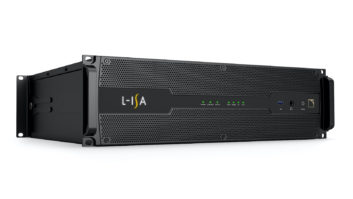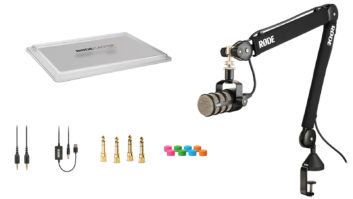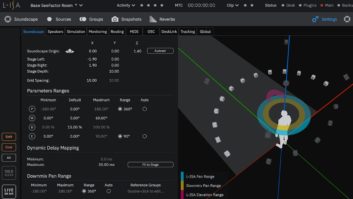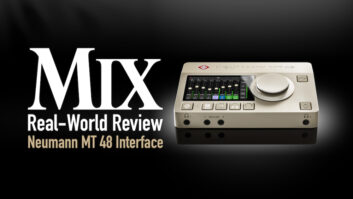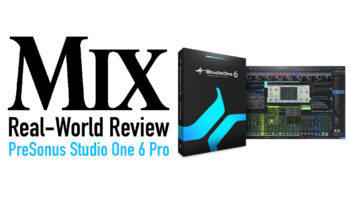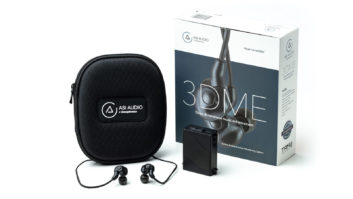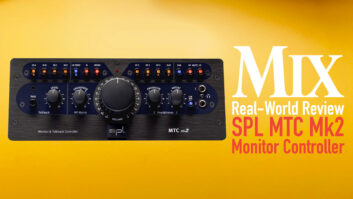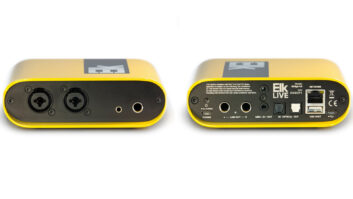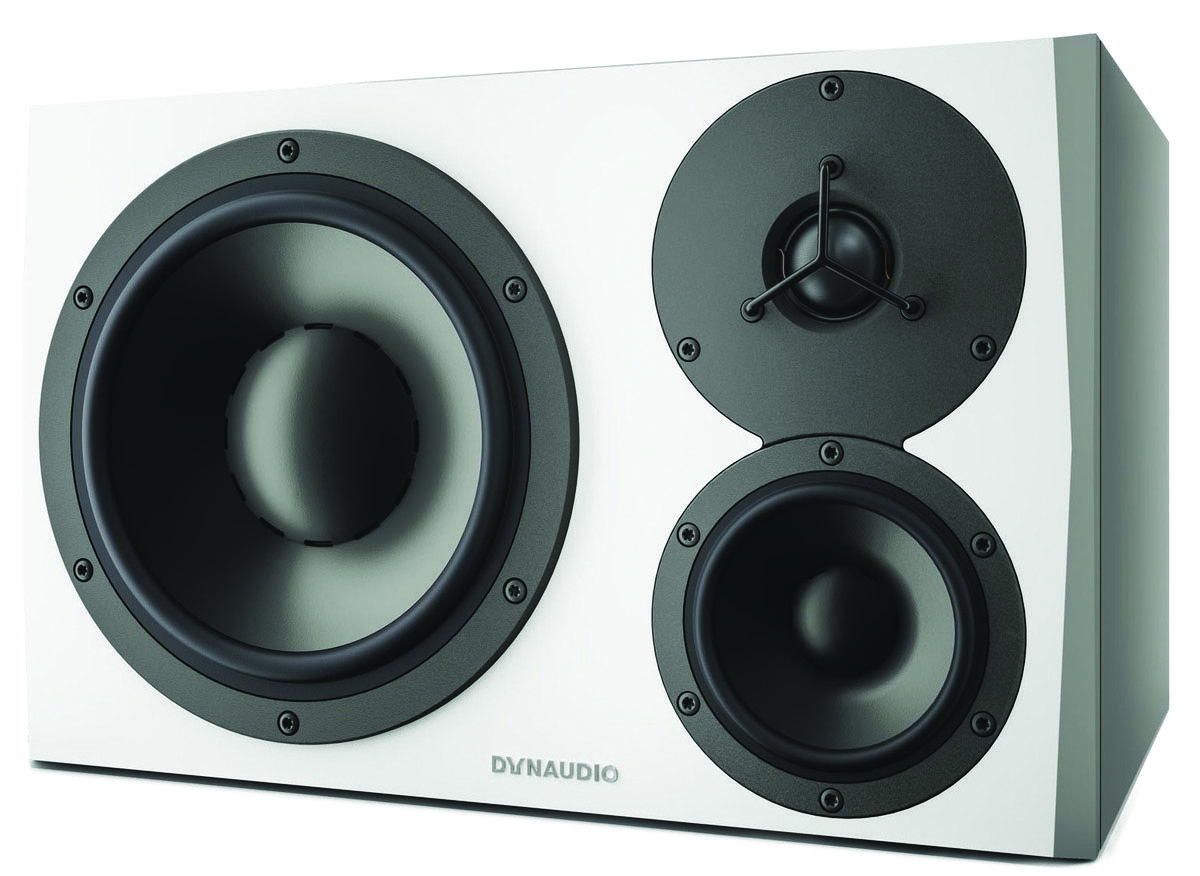
Dynaudio’s latest pro monitor line is a series of compact studio monitors called the LYD range. Three different two-ways, varying in scale based on their woofer size, serve as the foundation of the fleet, but the latest offering, the LYD 48, is the first three-way. This new model boasts an 8-inch magnesium silicate polymer (MSP, a signature of Dynaudio’s drivers throughout their product lines) woofer, 4-inch MSP midrange driver and a silk-dome tweeter. All of the LYD monitors feature DSP crossovers, a nice complement of DSP-based tone-shaping controls and discrete amplifiers for each driver.
The LYD 48s are housed in one of the smallest enclosures that I’ve ever seen for a three-way, which makes placement easy, even in smaller spaces. The way the drivers are oriented, with the center-points of the tweeter and 4-inch woofer aligned in a straight vertical line, and the 8-inch woofer off to the side, the monitors are designed to be placed horizontally. That said, in situations where, due to space, the monitors need to be placed upright, I still think they perform well. Just make sure to swap the units marked “left” and “right” so that the tweeters stay to the outside.
On the rear of the cabinet, toward one outside edge, there is a narrow, vertical bass port. The sculpted design flares out from the center toward the top and bottom of the cabinet. Near the other end of the cabinet’s back surface resides the control panel, for all of the sound-sculpting features and physical connections. An XLR connector provides a balanced input; unbalanced signals can be accepted through an RCA connector. While there is a handful of monitors (particularly those with digital crossovers) that can accept AES3 signals, this is not the case with the LYD 48s. This means that all incoming signals are converted at 24-bit/96kHz resolution to feed the EQ and crossover components, before being converted back to the amplifiers for reproduction.
All of the DSP controls fall into two categories: They either tailor the sound to help the monitors adapt to room characteristics, or they provide more headroom, allowing the monitors to reproduce louder sounds. In the former category, a Position switch compensates for low-frequency problems due to placement near walls. The Sound Balance three-way switch can be zeroed out to set a flat frequency response, or it can see-saw the frequency response for more highs and less lows, or vice versa. Even in its most extreme setting, the boosts and cuts are ±1.5 dB, which seems subtle on paper. Depending on the room and style of music being monitored, however, the effects can be pretty considerable.
The other control that has a significant sonic effect is a high-pass filter, dubbed Bass Extension. The rolloff can be set to 40, 50 or 60 Hz, with the intention of allowing higher reproduction levels before distortion. The reality that I’ve experienced, which is reinforced by the frequency response charts in the manual, is that choosing the lowest frequency setting also provides a bit of a bump near 40 Hz before starting its rolloff. To me, this setting seems a bit unnatural when monitors are running at what I consider to be normal playback levels. When running at much lower levels, however, this setting effectively bolsters the low end and sits a bit more naturally.
At first listen, the bottom end caught my ear. There were impressive lows that seemed to disperse evenly throughout the room. Even as I walked around, there was a tight clarity to bass elements. Likewise, at low volumes, the bass was much more substantial than I’ve experienced with other monitors. Both the manual and the product rep highly recommended an extended break-in period, so I ran the monitors at a moderate volume for several days before doing any serious listening.
The biggest change that I noticed after breaking them in was that the lower midrange, which was dialed back at first, filled in quite a bit. It seemed that the monitors also benefitted from a daily warmup before using them for any mixing. When cold, they would be kind of tight and muddy-sounding, but after an hour or so of steady playback, the midrange and overall stereo field would open up considerably.
For comparison, I wound up A-B’ing the LYD 48s against a few different pairs of monitors in different price ranges, the first of which were the Focal Twin 6 Be ($1,899). In this case, when listening to hip-hop or more electronically driven music, there were some low frequencies audible in the LYD 48s that the Focals couldn’t quite match. Through the midrange, the Focal pair generally felt flatter. When listening to more natural acoustic instruments, like piano, guitar or even drum kits, the lower midrange of the LYD 48s seemed to have a little bit of a dip in the body of the instruments. The gap between the two pairs narrowed a bit after the Dynaudio monitors were fully warmed, but there was always a bit of disparity.
The upper midrange seemed slightly pushed on the LYD 48s, and this was also true when testing them against a pair of KRK Expose E8Bs. This was particularly noticeable when listening to songs featuring female vocals or electric guitar solos. When listening to the Dynaudios, I would feel compelled to back off the overall level to avoid harshness, while the alternative pairs would allow me to listen comfortably at much higher volumes. Even when I adjusted the Sound Balance control to the “Dark” setting, which tilted back the highs and boosted the lows, the upper midrange felt a bit forward, and the lower midrange a little backed off. I spent a lot of time with the speakers in this setup, and they grew on me. The slightly accentuated upper midrange made them ideal for dialog editing, as they pointed out problematic mouth clicks, breaths and sibilance. Running at lower levels, the bottom half of the spectrum was warm and balanced.
When testing the LYD 48s against the KRKs, both monitors were set up in more of a mid-field configuration. In this case, the stereo image of the KRKs made the Dynaudios seem narrow by comparison. Using the LYD 48s as a true near-field, sitting on the desk, the image was a different story. Here they sounded very wide, while the center stayed nicely grounded in the middle. In modern indie pop songs, glittering synths danced around on the far outer edges of the soundscape, sounding as if they were far outside of the monitors. On a ’60s jazz track, soloists kept entering the picture farther and farther to the left, pushing the boundaries of the image. When listening to classical music, the arrangement bounced nicely from section to section across the space. Not only was the width impressive, but the depth was quite considerable, as you could hear the percussionists farther back in the room. Staccato notes managed to produce impressive attack, even in very quiet sections of the piece.
Once I got to know the monitors and found their loudness sweet spot, they performed much better in a well-treated studio. I was able to mix TV spots at ATSC-approved loudness levels consistently without having to rely heavily on metering. I could confidently compress and EQ elements within mixes of both the music and post-production variety with very translatable results. The final products sounded great on all types of speakers, from the phones and TVs to car audio systems, as well as on other professional monitors. I could listen for long periods of time without getting fatigued. Altogether, they turned out to be very useful reference monitors.
LYD 48s are at their best when averaging at lower volumes and when placed as true nearfields. If you’re looking for something that can shake the room for loud hip-hop sessions, these monitors can get loud, and their bottom end can produce some big rumble, but their overall character suffers at higher volumes.
On the other hand, if you typically sit alone in a room with your mixes, or if you have a tricky room and want to put more money into monitors than treatment, the LYD 48s could be your savior. At modest levels, the monitors perform with impressive accuracy throughout the entire frequency spectrum. The detail in the top end is fantastic, the transient response is on point, and the low end is quite substantial while being well-controlled. If you’re shopping in this price range, you should give these a listen.
PRODUCT SUMMARY
COMPANY: Dynaudio
PRODUCT: LYD 48
WEBSITE: www.dynaudio.com
PRICES: $1,149 (each)
PROS: Great detail, transient response and low end. Useful tone-shaping controls.
CONS: Midrange can be strident at higher volumes.
